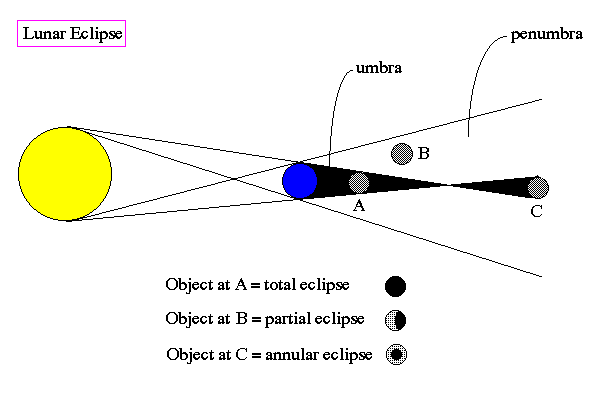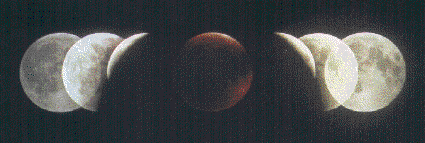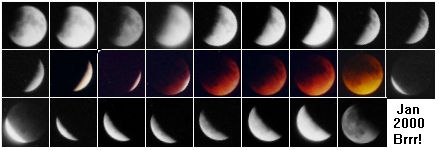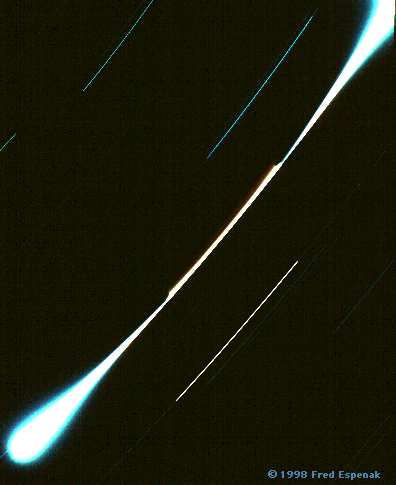Mechanics of the Eclipse :
How does it work (what is a lunar eclipse)? One face
of the Earth always faces the Sun, and thus there is a "shadow" from
the Earth that points outward into space on the opposite side from the Sun. The
shadow lies in the Earth-Sun orbital plane. The moon has an orbit that is plane
that tilts just slightly with respect to the Earth-Sun plane. Occasionally, the
Moon will cross the Earth-Sun plane (twice an orbit) - and even more rarely, it
will make that pass when the Earth's shadow is there (causing the light from
the Sun to be blocked by the Earth). [The Moon can also touch the Earth-Sun
plane between the Earth and the Sun - causing a Solar Eclipse.] Notice that the
adjective in front of the word eclipse tells what object is being
"blocked" ... a lunar eclipse has the Earth blocking the light to the
Moon and a solar eclipse has the Moon blocking the light from the Sun.
It is a fortunate situation that the Moon's angular size
(how big it appears in the sky) is basically the same as the Sun (sometimes
larger, sometimes smaller). Now, as for the tilt of the Moon orbit - that
prevents the eclipses from happening roughly twice a month (every 27.3 days).
Is that a good thing or bad thing? Well, without the tilt .. eclipses would be
"humdrum" - they would occur so often we would take them for granted.
When they are rare, we do foolish things like sit outside all night in January
in Michigan to take a few snapshots (more on that later!).


Eclipse Photography!
This can be done very cheaply (simple 35 mm camera can take
some very interesting shots!). Here are some from the Internet, and some that I
took myself during this past January's Lunar eclipse (it was cold!!) You can
see more from my outing
here.
Montage Photo by Akira Fujii
Shows size of Earth's shadow.

|
Telescope Image during Totality

|
Scott Schneider's Eclipse Montage !

|
|
Eclipse Trail Photo by Fred Espenak
Leave camera open to record change in brightness.

|
Why are the images near totality reddish in
color? You have to see the
eclipse
page to find out!
More information about the Moon Eclipses and Solar Eclipses
- The Moon has a period of 27.3 days (and rotates around the
Earth in the same "sense" as the Earth rotates around the
Sun).
- When we have a Full Moon, the lineup is Sun - Earth - Moon
(possibility of Lunar Eclipse)
- When we have a New Moon, the lineup is Sun - Moon - Earth
(possibility of Solar Eclipse)
- Rules of Eclipses (Solar and Lunar)
- Lunar eclipse occurs on Full Moon - Solar on New Moon -
there isn't always an eclipse each month
- At least two solar eclipses occur in a year, and never more
than five. Maximum of 3 lunar eclipses in a year. Highest number of total
eclipses equals seven.
- Eclipses tend to go in pairs or threes : solar-lunar-solar.
Lunar eclipse always preceeded by or followed by a solar eclipse (two weeks
between them)
- Saros cycle = pattern of eclipses = 18 years, 11 days, and
8 hours - pattern not repeated exactly
- Lunar eclipse - maximum duration = 1 hr 40 min (total) and
3 hrs 40 min (partial-total-partial)
- Solar eclipse - maximum duration = 7 min 40 sec (total - at
equator) and 12 min 24 sec for annular eclipse
- Bright crescent of the Moon points to where the Sun is in
the sky :
- Waxing moon - getting brighter .. between New and Full (in
sky near sunset, shifts later to midnight)
- Waning moon - crescent getting smaller - between Full and
New (in sky near midnight, shifts closer to sunrise)
- Moon is high or low in the sky in the opposite sense to the
Sun
- In the Summer - Sun is high in the sky in the
Northern Hemisphere - so the Moon will be lower in the sky
- In the Winter - Sun is low in the sky in the
Northern Hemisphere - so the Moon will be higher in the sky
- [Essentially, the Moon in Winter takes the Summer Sun's
path, and Moon in Summer takes Winter Sun's path.]
- Draw line bisecting the crescent - that indicates the
Moon's curve through the sky
- At the highest point - crescent should point either East or
West (parallel to the horizon)
- Near the horizon (rising or setting) - will make large
angle with horizon in winter - make small angle with horizon in Summer
- Moon "advances" an average of 50 min each night
(in 27.3 days the Moon moves around 24 hours in its path)
- Suppose you look at 10:00 PM and see the moon .. the next
night you would have to wait almost an hour for the moon to be in the same
place
- (But, naturally, a different phase!)
- Can we watch the rise/set times in the local paper and see
this 50 min shift?
- NO! - Remember we have shorter nights in Summer and longer
nights in the Winter - this will throw us off!
- We could try to watch for the Moon to be at its maximum
altitude on successive nights?
- These times will vary between 42 and 64 minutes difference
between successive nights
- [This is a combination of the Earth's elliptical orbit and
the Moon's elliptical orbit]


